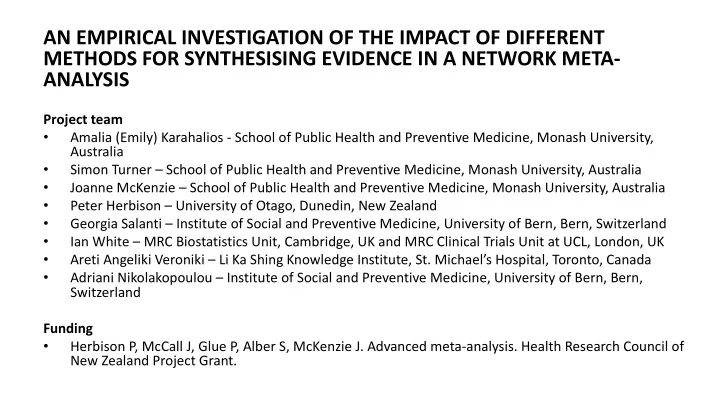

AN EMPIRICAL INVESTIGATION OF THE IMPACT OF DIFFERENT METHODS FOR SYNTHESISING EVIDENCE IN A NETWORK META- ANALYSIS Project team Amalia (Emily) Karahalios - School of Public Health and Preventive Medicine, Monash University, • Australia • Simon Turner – School of Public Health and Preventive Medicine, Monash University, Australia • Joanne McKenzie – School of Public Health and Preventive Medicine, Monash University, Australia • Peter Herbison – University of Otago, Dunedin, New Zealand • Georgia Salanti – Institute of Social and Preventive Medicine, University of Bern, Bern, Switzerland • Ian White – MRC Biostatistics Unit, Cambridge, UK and MRC Clinical Trials Unit at UCL, London, UK • Areti Angeliki Veroniki – Li Ka Shing Knowledge Institute, St. Michael’s Hospital, Toronto, Canada • Adriani Nikolakopoulou – Institute of Social and Preventive Medicine, University of Bern, Bern, Switzerland Funding Herbison P, McCall J, Glue P, Alber S, McKenzie J. Advanced meta-analysis. Health Research Council of • New Zealand Project Grant.
Aim/methods Assess impact of re-analysing published NMAs with binary outcomes using contrast- • synthesis and arm-synthesis models Investigate results w.r.t. characteristics of the NMA (not presented here) • # treatments: # studies – # treaments: # comparisons – # studies : # treatments – proportion of arms with <10 events/outcomes –
Eligibility criteria • We included a subset of networks from a database of networks of randomised trials (Petropolou et al 2016) • Our subset included networks meeting the following criteria: – Primary outcome was binary – No evidence of inconsistency – Outcome data available Petropoulou et al, J Clin Epi (2016), doi: 10.1016/j.jclinepi.2016.11.002
Flowchart of networks included in analysis 456 networks 272 excluded: No or incomplete outcome data No binary outcome 184 eligible networks with outcome data 26 excluded: 3 contained missing data 23 p-value of design by treatment less than 0.10 158 networks
Statistical methods – using R Method label Package used Contrast-level Frequentist or Likelihood and Heterogeneity Prior distributions in R or arm-level Bayesian link functions input data framework Treatment specific Mean effect of Heterogeneity or fixed effects treatment k random effects relative to baseline parameter d k ~ N(0, (15*5) 2 ) Contrast- gemtc Arm-level Bayesian Binomial Homogeneous/ N/A τ bk ~ U(0,10) synthesis model 1 (version 0.8.1) likelihood and common logit link d k ~ N(0, (15*5) 2 ) Contrast- gemtc Arm-level Bayesian Binomial Homogeneous/ N/A Informative synthesis model 2 (version 0.8.1) likelihood and common logit link Contrast- netmeta Contrast-level Frequentist N/A Homogeneous/ N/A N/A N/A synthesis model 3 (version 0.9-2) common Arm-synthesis pcnetmeta Arm-level Bayesian Binomial Homogeneous/ N/A µ k ~ N(0, 1000) σ k ~ U(0,10) model 1 (version 2.4) likelihood and common probit link Arm-synthesis pcnetmeta Arm-level Bayesian Binomial Heterogeneous N/A µ k ~ N(0, 1000) σ k ~ U(0,10) model 2 (version 2.4) likelihood and probit link
Preliminary results Using graphical displays, we have compared estimates of the following parameters between the four models: • log(OR) • standard error(log(OR)) • ranks derived from SUCRA values
Flowchart of networks analysed 158 networks available 7 networks had 1 or more treatment arm that failed to run using arm-synthesis model 1 151 eligible networks with outcome data 31 networks failed to converge using one or more of the Bayesian methods*: contrast-synthesis model 1: 11 contrast-synthesis model 2: 13 arm-synthesis model 1: 25 120 networks available for analysis *Numbers do not sum to 31 because some networks failed to converge for more than one model
Time taken after excluding the networks that failed to converge (n = 120) Time taken (minutes*) Model Average SD Median Minimum Maximum Contrast-synthesis model 1 5.24 4.32 4.00 1.00 20.00 Contrast-synthesis model 2 5.26 4.40 4.37 0.00 19.66 Contrast-synthesis model 3 0.00 0.00 0.00 0.00 0.00 Arm-synthesis model 1 98.89 202.49 37.14 6.55 1262.66 *Note that all times measured in minutes
Comparison of the effect estimates and standard errors
4 5 3 6 2 7 8 1 2 studies treatment 1: 2 events, 81 participants treatment 7: 61 events, 172 participants
Comparison of the ranks and SUCRA values between methods
Summary From our preliminary results: • – Good agreement between the contrast-synthesis methods in terms of effect estimates and treatment ranks – Differences are apparent in the effect estimates and ranks when comparing the arm-synthesis model to the contrast-synthesis models – Contrast-synthesis models have larger standard errors compared to the arm- synthesis models – More variability with respect to the standard errors for the arm-synthesis models compared to the other models Next steps: • – Examine another arm-synthesis model – Fit multilevel models to estimate the differences between the methods and to explore the factors that might explain the differences
Recommend
More recommend